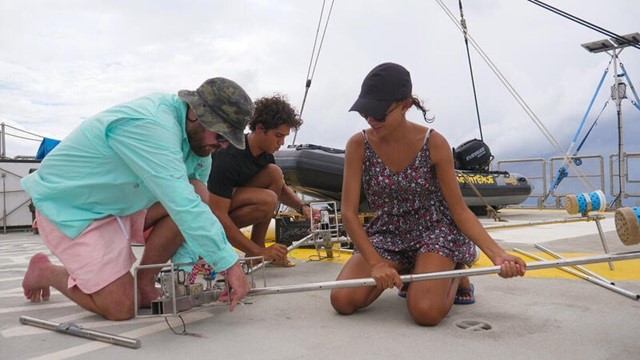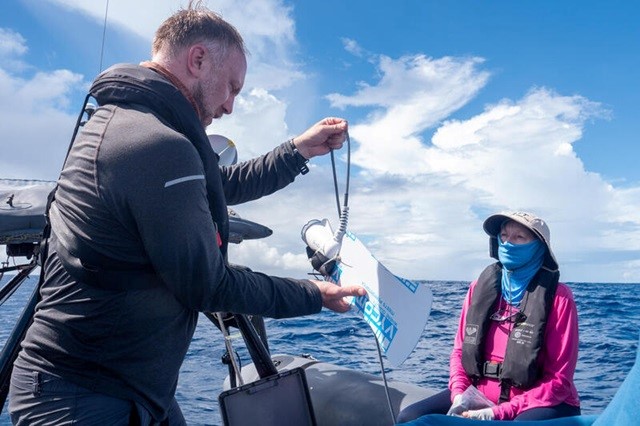Greenpeace teams up with University of Seychelles for seagrass research onboard Rainbow Warrior
Victoria, Seychelles | April 24, 2024, Wednesday @ 09:17 in Environment » RESEARCH | By: Betymie Bonnelame
(Seychelles News Agency) – The Greenpeace ship, the Rainbow Warrior, arrived in Port Victoria in Seychelles after a week-long expedition with a team of scientists and students from the University of Seychelles exploring the seagrass meadows around Owen Bank in the western rim of the Mahe Plateau.
In a press communique on Saturday, the global environmentalist campaign network, Greenpeace, said that the seagrass meadows in this region remain largely undocumented so the Rainbow Warrior is supporting the team from Seychelles to verify their extent and document the diverse marine life within this vital ecosystem.
“This expedition aims to provide a missing piece to the puzzle of knowledge about seagrass meadows in Seychelles waters – research the University of Seychelles has been carrying out with other partners within the Seychelles Seagrass Mapping and Carbon Assessment Project over several years,” said Greenpeace.
The scientists conducted 166 surveys of seafloor habitats with an underwater camera, 32 deployments of baited underwater video systems (BRUVs) to collect data about the fish and other species living in the area and retrieved two sediment core samples from the seabed to determine how much carbon it is storing.

The findings show that Owen Bank is home to vast and healthy seagrass meadows and diverse communities of fish, sharks and rays, among others.
At the same time, the area is vulnerable to threats such as warming oceans due to climate change as the scientists witnessed coral bleaching concurrent with record bleaching on coral reefs globally this year.
Dr Laura Meller, Greenpeace‘s Protect the Oceans policy adviser on board the Rainbow Warrior, said, “We’re really proud to be supporting the scientists and students from the University of Seychelles on this critical research expedition to complement previous work and we hope that it helps the Seychelles government in achieving its aim of protecting 100 percent of the seagrass meadows in the region.”
Dr Gwilym Rowlands, senior research fellow at the University of Oxford, said, “This study allows us to fill a major knowledge gap in the distribution of seagrass habitats and their associated biodiversity in Seychelles, working on the remote edge of the Mahe plateau.” He further explained that this will allow this area to be properly considered in further designing marine management of Seychelles’ waters.

Three students taking part in the expedition had the opportunity to participate in all the research activities that not only improved their understanding of marine systems in the Seychelles but also on the techniques and methods used to study various aspects of the ocean. They also learned how to use them for decision-making and address issues the country has regarding its marine resources.
The three students on the research expedition were Maria Anacoura, Amelia Desire and Loïc d’Offay.
Anacoura said, “The past week has been a great eye-opening experience, allowing us to see and be part of the behind the scenes of a research expedition. It was inspiring to see the world underwater, and there was a lot of megafauna such as tiger sharks, white-spotted wedgefish and even a great hammerhead shark! This has given us renewed passion to pursue protecting the environment when we now know what we are protecting.”
The acting director of the Blue Economy Research Institute at the University of Seychelles, Dr. Jérôme Harlay, said the support offered by Greenpeace has been instrumental for the research the institute is undertaking.
This is being done to support the decision-making of the Ministry of Agriculture, Climate Change and Climate Change and the Ministry of Fisheries and the Blue Economy to ground-truth seagrass meadows at the periphery of the Mahe plateau.
“Seychelles is about to protect 50 percent of this habitat in 2025 and 100 percent in 2030. The data collected will not only allow us to sharpen the GIS [geographic information system] layer of seagrass but also help us assign them an ecological value for their contribution to biodiversity and habitat connectivity,” said Harlay.
Seychelles recently became the third country in the world to ratify the UN High Seas Treaty, a legally binding agreement that puts conservation and equity at the heart of global ocean governance. The Treaty only comes into force once 60 countries ratify it.

Leave A Comment